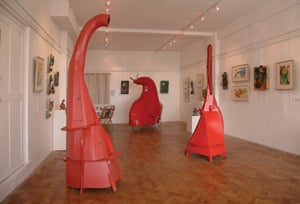Turning the Tide
Alastair Fairley reveals how a community of artists and a hard-nosed drive for publicity put Hastings firmly on the cultural map

The opening in March of the £4m Jerwood Gallery on Hastings’ seafront has, like Margate’s Turner, Eastbourne’s Towner and Chichester’s Pallant House, set Hastings firmly on the roster of must-visit day-out destinations. From dowdy, run-down coastal resort, the town is now alive with festivals, music and performance; commercial galleries pepper its narrow streets and Mozart, not litter, blows across its seafront as visitors savour its weekend offer of sunshine and fish and chips with a liberal slosh of culture.
But while the Jerwood Foundation’s most ambitious new venture attracts the headlines, the real work to turn the town into a cultural hot-spot was started not by wealthy arts charities, politicians or regeneration agencies, but by a small band of dedicated arts professionals who got together, got organised and stuck in to making change from the grass roots up.
In 2003 the Hastings Arts Forum was just the germ of an idea. A pocket of deprivation in an otherwise well-off South East, the town had long been a destination for artists, yet developing the town’s cultural offer as a way out of its ills was an idea which escaped its political leaders. Regeneration monies focused on shiny new offices for ‘creative industries’. The town’s only arts centre was threatened with closure. From a huddled meeting of just ten diverse artists, the decision was clear: it was time for action.
Word was put out and subsequent meetings – of 20, 40 and 70 crowded in dingy basements – quickly showed we had touched a nerve. With encouragement, and a little money from our local voluntary community service, the Forum was formally established in 2003 at a conference for 200. Its aim? ‘To promote and develop Hastings as a major centre for the arts’.
What followed seems logical only in retrospect: at the time it was more a case of bursting out in every direction possible. A demonstration outside the Town Hall campaigned against the closure of the arts centre. Representations were made to stonewalling politicians. Television coverage made the news. But the first real inroads towards transforming attitudes came from working within the political environment. As chair of the newly formed Forum, I had also been elected to the town’s Community Network, a diverse array of voluntary groups representing the community on the Local Strategic Partnership (LSP), in turn responsible for achieving the town’s regeneration strategy. Jobs, education, housing, health: as far as we were concerned culture and the arts could help improve quality of life in all these fields.
By chance, it was to be the Community Network’s turn to chair the LSP for the next two years, a role which colleagues felt I was qualified to take on also. Within months I found myself chairing a highly vocal arts organisation, and the very organisation responsible for achieving change for the town’s 75,000 residents. What was needed, we argued, was a ‘cultural shift’. Couldn’t health, employment, enterprise all be improved by using culture and the arts – and the creativity of hundreds of artists – to better our town’s fortunes?
At first, our cries fell on deaf ears, yet we were not to be swayed. A culture sector sub-group of the LSP was established. Approaches were made to Government, the Arts Council, the Regional Development Agency and the Learning and Skills Council. Wherever opportunities to sit on any funding or regeneration committee arose they were leapt at, all the while reporting back to the arts community via monthly meetings on any progress made. It was long, frustrating and, at times, fruitless work.
The real transformation in attitudes came only when the Forum decided to start delivering the services our members required. With a small loan from myself and a colleague, a shabby yet listed seafront shop was rented in a vacant lot on nearby St Leonards’ seafront. Many thought us mad. We thought it ideal.
Floors were sanded, telephone lines installed, a computer obtained, and a first-rate flexible hanging and lighting system acquired for what was to be our first in a weekly-changing rota of exhibitions. The town’s first community-run art gallery took off like a rocket. Within the next two years the Arts Forum had acquired the next-door building as a second gallery, held over a hundred art exhibitions, obtained a mass of publicity and seen its membership rise from a dwindling 50 to over 800 members spanning the cultural sector.
More artists came to settle, each welcomed with professional support, a destination to show their work and a readymade hub of kindred spirits with whom to mingle. Funded programmes for the sector were taken on. Arts Council grants flowed. Screen South made it a regional hub for its film sector. Its success had regenerated an entire row of shops, bars and other galleries in one of the town’s most run-down areas. More importantly, with its hard-nosed drive for publicity, it had truly put Hastings on the cultural map.
It was this combination of hard lobbying with direct action that formed both the Forum’s foundations, and its ultimate success. But getting that message across is a task which always requires repeating. Having been approached by the Jerwood considering where to site its new gallery, the local Council turned to the Forum for help in preparing a response. But even as officers considered business rates and development locations, a lone voice could be heard at planning meetings stressing the need for an artistic response to the Jerwood’s approach, as well as a corporate, commercial one. The results now stand for all to see, nestled amongst the ancient net huts on Hastings Old Town beach. Headlines aside, from the Hastings Arts Forum’s perspective, a ten-year goal has been truly well achieved.
Join the Discussion
You must be logged in to post a comment.